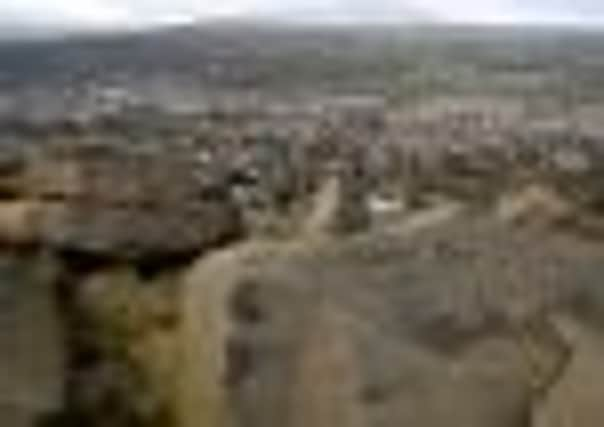Profile on...


IF you want to give to charity while shopping in Otley, hover by the Jubilee clock at the Buttercross and someone will be happy to relieve you of your donation.
This is the spot in the mid-Wharfedale town for charities wanting to raise funds to set out their stalls, or just stand with a collecting box, but it is also the place to sit and watch the world go by, chat or meet. Elderly women rest with their shopping alongside businessmen and school pupils pausing to eat their lunch, all sitting on old wooden, backless benches regardless of season or weather. Like the ubiquitous under-the-station clock meeting point, in Otley everyone meets at the Buttercross.
Advertisement
Hide AdAdvertisement
Hide AdLike its near neighbour the wealthy former spa town of Ilkley, it lies in the mid-Wharfe valley on the banks of the River Wharfe which for most of its 60 miles marks the boundary between North and West Yorkshire.


Wharfe is a Celtic name meaning twisting or winding which is what it does for most of its journey from its source at Beckermonds, high in Langstrothdale in the Yorkshire Dales National Park, flowing down through such tourist hot spots as Grassington and Bolton Abbey in Upper Wharfedale on its way through Ilkley and Otley, Wetherby and Tadcaster, before emerging into the River Ouse near Cawood, south of York.
One of the things that link Otley, Wetherby and Tadcaster is that they all have historic weekly markets which are still held today. Local produce plays an important part in sustaining the rural economy along the length of the valley whether in the shops or at the farm gate where it is possible to buy anything from eggs and meat to fish from local hatcheries.
Otley is a proper market town at the heart of its local rural life – there has been a local market for more than 1,000 years – but also a tourist town, as reflected in the smattering of craft, specialist and book shops, restaurants, and in its history.
Advertisement
Hide AdAdvertisement
Hide AdThis is where the celebrated English landscape painter JMW Turner, when commissioned to do a number of works in the early 1800s, became captivated by the Wharfedale scenery and its light. His oil painting Snow Storm: Hannibal and his Army Crossing the Alps, which hangs in the Tate Gallery, in London, is said to have been inspired by a view of Otley Chevin under a stormy sky.


Thomas Chippendale, the furniture maker, was born in the town and his statue stands next to the old grammar school that he attended, while the Methodist preacher John Wesley was a frequent visitor in the 18th century.
Modern day notoriety has it playing the town of Hotton in the television soap Emmerdale.
Six miles upstream lies Ilkley, the gateway to Upper Wharfedale and the Olicana of Roman times but historically going back to the Bronze Age, beneath the slopes of Ilkley Moor, another vantage point for Wharfedale’s spectacular scenery.
Advertisement
Hide AdAdvertisement
Hide AdNow a thriving and prosperous commuter town for Bradford and Leeds with its upmarket shopping, and eating establishments and tree-lined streets, its Victorian architecture is a throwback to the days when it was a spa town. Tourists who flocked to take the waters at the now-demolished Hydro included Charles Darwin, who was receiving hydropathic treatment when his Origin of the Species was published in 1859.
Lead mining was the main industry in Upper Wharfedale, the area above today’s honey-pot village of Grassington, between the 17th and 19th centuries employing hundreds of men and boys, but today tourism is a major part of the economy with brewing making a comeback.
It must be something in the water of the River Wharfe, as Otley once boasted more pubs than anywhere in the country, and a number of micro breweries have sprung up in the past few years in Upper and Mid-Wharfedale.
Lower down the valley, Tadcaster, another Roman town and once a staging post on the London to York road, still has three breweries, with the earliest mention of brewing in the town being in 1342.
Advertisement
Hide AdAdvertisement
Hide AdHowever, the town has a rather more celebrated place in history with the Battle of Tadcaster being fought around the river bridge during the Civil War, and three miles away the Battle of Towton in 1461 settled the Wars of the Roses.
Today, it is more peaceful and like Wetherby since being bypassed no longer has traffic thundering through.
Wetherby is another thriving commuter town with a market whose Royal Charter was granted in 1240 and which is still held every Thursday. It too was a Roman settlement and it also played its part in the Civil War.
Now it is another wealthy commuter town relying considerably on tourism with its attractive shopping centre, as well as having Yorkshire’s premier National Hunt racecourse.
WHARFEDALE FACTS
• One of the longest of the Yorkshire Dales.
• Takes its name from the 60-mile long River Wharfe.
Advertisement
Hide AdAdvertisement
Hide Ad• River source is Beckermonds in Langstrothdale, but Wharfedale begins officially at Buckden.
Upper Wharfedale is upstream from Grassington and Lower Wharfedale below Threshfield.
• The Wharfe is a public navigation from the weir at Tadcaster to its junction with the River Ouse near Cawood, and tidal from Ulleskelf.
• Classic Dales landscape of wild beauty, farms, dry-stone walls and barns, with flower-rich hay meadows and stunning scenery.
• Geology of the area includes Millstone grit, limestone and sandstone.